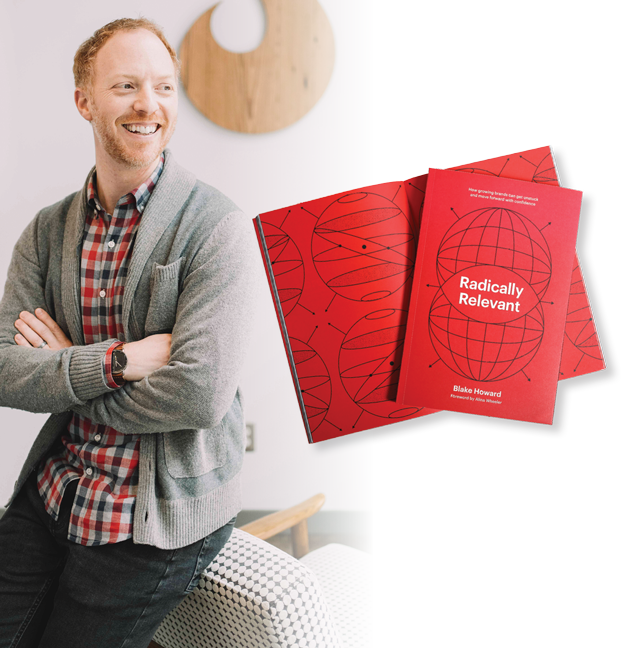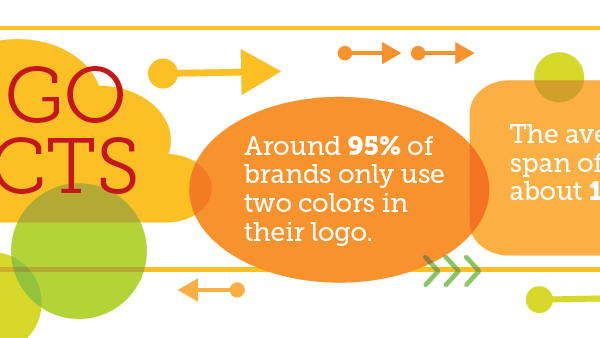The ad industry veteran talks rebranding exercises, the importance of brand clarity, ways to govern your brand identity, and why branding doesn’t have to be as complicated as we like to make it.
Blake Howard says he authored his new book, Radically Relevant, to “condense 20 years of brand strategy, as well as visual and verbal identity thinking, into a single source that could help organizations that are looking to change but aren’t quite sure how.” The cofounder of Matchstic, an Atlanta-based brand identity firm, Howard has spent two decades helping growing companies improve their brand identity, leading numerous brand relaunches for a wide range of clients—from globally recognized brands such as Boys & Girls Clubs of America, Chick-fil-A, and Publix to ambitious start-ups looking to put themselves on the map.
Radically Relevant is meant to be a thought starter—or a primer—for having the confidence to move forward, and Howard’s timing is impeccable. As anyone who has dipped even a toe in the marketing pool knows, the ways of communicating with customers are evolving at breakneck speed. Today, stepping into just the shallow end can feel more like leaping onto a moving train.
“People often want to make a change, but they don’t know how, when, or where,” Howard says. “And because everything is changing, rebrands are probably more precious or sensitive. If you get it wrong, the world could be watching, so it feels like there’s more pressure to get it right. At its core, the book is really about helping people figure out where they are and what they need to do next.”
If the idea of another marketing book filled with too many details to wrap your head around is a turnoff, don’t fret. Howard believes that while branding can be complicated, it doesn’t necessarily have to be. In fact, he believes it’s often as simple as being different and being valuable. “The Radically Relevant book is designed to simplify what can often be overly complicated and complex,” Howard explains. “As a friend of mine once said, ‘Brand people tend to overcook their omelets.’”
After giving Radically Relevant a read, we fired a few questions Howard’s way to give you insight into what’s behind the book and what you can expect to find inside.
”Absolutely. Mission, vision, and values are corporate communication tools that are different from the brand
ON REBRANDING
Q: For a rebranding exercise, do you subscribe to building an internal “brand platform” and building blocks that tell the organization what the company stands for and sounds like: mission, values, product promise, etc.?
Blake Howard: Absolutely. Mission, vision, and values are corporate communication tools that are different from the brand. So, when it comes to developing a brand platform, we help clients think through brand personality—attributes that simply articulate how they should show up in the world. We then work on brand positioning. That means asking, “Compared to a very tightly defined competitive landscape, how are we going to tell our story differently?” We also create audience personas, and we work through a psychographic persona where it’s more about the mindset and determining whom we are designing the brand for. We think that’s absolutely essential for creating alignment inside the organization about what it is we’re trying to represent out in the market. That platform then becomes an anchor before getting into subjective, creative territory such as names, visuals, or verbals.
Q: In the book, you list the things that a brand is and is not, including that a brand is what others say about you, not what you say about yourself. Where do you see the crossover between what a company thinks it should look like, sound like, or behave like and the customer’s opinion of that company?
BH: The two are absolutely connected. Too many people think it’s only about what the company says the brand represents, and they fail to realize that it’s a two-way marketplace. There’s often a gap between how companies want to be known and how they are actually known. The idea is to define how you want to be known and then make strategic, tactical decisions that can make that a reality. For example, if you want to be a trusted brand, make sure you treat your design in a credible, trustworthy manner; don’t go wild with your aesthetic, which could send mixed messages. Once you’ve defined how you want to be known in the market, make smart decisions on how you should show up to reinforce how you want to be known and, of course, deliver on those promises. Over time, you can shrink the gap between how you want to be known and how you’re actually known.
Q: If a company does the “brand platform” exercise, should their baseline be where they are in their customers’ eyes now (reality) or where they want to go (be the market leader, for example)?
BH: Brand strategy is about defining both the ideal and the future. There’s certainly a nod to the current reality of where you’re coming from, because you don’t want to be tone-deaf to that. However, it is also about creating signposts that point you in the right direction of where you want to ultimately head in the future. Sometimes, when a brand such as Twitter rebrands to X and is going to be this all-in-one, new platform that’s going to blow our minds, it doesn’t really pass the sniff test. It’s maybe too far into the future, and we need some specificity. So, it is about the ideal; however, you do need to know how you’re currently being perceived by consumers so that you can bread crumb and lead them along the way without jumping too far too fast. A big part of the Radically Relevant model is based on what consumers are looking for. So, the relevant side is very much about speaking value to them, not just tooting your own horn.
CREATING BUY-IN
Q: You write about the need to organize offerings that are meaningful to the audience, not based on internal politics. Any advice on how marketers can remove or limit the politics from these decisions?
BH: If it’s a big enterprise, it’s going to be hard to get everyone in the loop and involved, so education is a large piece, as well as making sure executives have bought in to the need for good, clear brand communications. If you have air cover from executive backing and endorsement, then you can educate and slowly change the internal culture over time. In a smaller organization, it’s beneficial to bring the squeaky wheels into the fold to make sure they feel heard and understood. Slowly, through that experience you can educate them and make decisions as you go in an attempt to find a win-win. People are used to doing things a certain way, so there’s definitely a change management psychology behind many internal politics.
STANDING OUT FROM THE CROWD
Q: One of the Super Six you list in the book is Distinction—standing out from the competition. Is there a fine line between examining—or worrying about—what the competition is doing and deciding who you are and what your brand represents?
BH: In the book, I say, “Don’t sacrifice CLARITY on the altar of DISTINCTION.” First and foremost, you need to be super clear, which is a pretty basic need. Then, distinction is also important, but I think people overindex on looking at their competition and being too worried about what they’re doing. Being authentic and matching the brand expression with mission, vision, and values are most important. However, distinction is key for brands that are trying to break out. Liquid Death is an example of a water brand that is completely bananas and weird, but they sure are making headway, and it’s just because they’re super different. I don’t think they’re sitting around worrying about their competition. They saw an opportunity to tell a different story through the name of the company and their visuals and, really, the theme of the entire brand.
Q: When you do a competitor analysis for a brand you work with, how do you advise them on this topic?
BH: We can make decisions that best match the brand platform, and we can make decisions that maximize opportunities noticed in the market. Often, we’ll see things like jargon phrases being used frequently in their marketplace, so we’ll try to avoid those. Or maybe everyone is blue and red in a market, so let’s explore green because one of our attributes is connected to growth and so that makes sense. From brand voice and color to the overall look and feel, we definitely leverage competitive opportunities and try to put that into the work.
Q: You write about finding the “one thing” for a brand to be remembered for. This can be challenging for internal brand teams whose time is requested by various departments or product teams, for example. Any tips on how to narrow the focus when the requests are coming from all angles?
BH: Sometimes we do a five-year-old exercise, where you ask, “What’s the value that we provide?” Someone may respond with, “We provide high-quality e-commerce solutions.” The trick is to keep asking, “Why?” (like a five-year-old would) to get to a simpler version of the story. What I like about this exercise is that it elevates above individual products, features, or campaigns, and it gets to this higher level of “Why do we actually exist?”
Q: Two of the categories that determine a Radically Relevant brand are Attraction and Devotion. Today, brands attempt to align (and share) their values with the perceived opinions and values of their audience. Do you see this trend continuing?
BH: It depends on the brand and the organization. Unfortunately, there isn’t a one-size-fits-all approach. It’s mostly based on your audience—who they are and what they want. If it’s a nonprofit that is working on global sustainability, their audience is going to really care about the mission of the nonprofits they support, their belief systems, and their point of view on broader topics than just their mission as an organization. At that point, it makes sense to extend and share your values. But when it comes to consumer brands, I do think that’s a bit of a trend. I think people have responded to the events of the last five years, and many brands have tried to capitalize on trends that are mostly polarizing political topics, but they’re choosing a side so that they can cash in on it. People are starting to smell the inauthenticity there and the virtue signaling, which is a big turnoff. When it adds value and is relevant to whatever your value proposition is, it’s great to be authentic and share your belief systems, but when it’s irrelevant to the value you provide, it’s off-putting. It’s also difficult because a brand is not a one-dimensional, single person—a brand is often made up of and supported by hundreds of people internally. So, to pick a side is challenging for employees and for teams. Individuals have opinions; brands don’t always have to. That doesn’t have to mean brands are insensitive, but they should be more critical about what’s authentic and what’s simply opportunistic.
BRAND GUIDELINES
Q: The book discusses the clever idea of appointing a governor of the brand who acts as a source, not the police. What brands have implemented this, and how has it worked?
BH: Publix is where I first got this idea. They have 60+ people on their in-house creative services team, with multiple creative directors. We worked with the executive creative director to help put together brand guidelines, and his posture was to not give a bunch of dos and don’ts and paint a picture of what’s wrong, but to let the brand guidelines act as inspiration instead—to be a source to reference what works best. We ended up presenting everything that was the bright spot of how the brand should come together. I always liked that it was really more about inspiration and less about policing. They also do monthly huddles and reviews where teams share creative work and talk about it, so that is a chance to get inspired about what’s working best. Chick-fil-A also does monthly and quarterly “brand schools” where they share work and discuss what’s working best. That’s another example of being a great source of inspiration instead of being an auditor looking to catch someone making a mistake.
Q: Every brand has visual guidelines, templates, and fonts, but tone of voice can be challenging to govern with numerous individuals speaking on behalf of the brand—copywriters, HR, social media, agencies, sales reps, and, in some cases, even brand store employees. How do you recommend constructing the brand voice?
BH: It’s a matter of knowing the cultural reality of the organization and understanding where your consumers or customers are coming from. If it’s a tech business that offers solutions in a high-stress environment, having a fluffy, soft voice is not sensitive to where your customers are coming from. It’s three parts: being authentic to the company, understanding where your customer is coming from, and understanding the competitive landscape. There’s often a huge opportunity to define your brand voice in a unique way based on avoiding certain slogans, tropes, and jargon used in your industry. There are a number of ways to construct a brand voice, but we tend to use brand attributes made up of really simple adjectives, and then we define those in a way that makes sense tonally and from a writing or tactical perspective. If we want to be bold, we’ll use short, pithy phrases for headlines. If we’re approachable, we try to write at a fifth-grade level and make it plainspoken and down-to-earth. Another approach is to create a brand archetype, like we are “the Explorer” or “the Bright-Hearted Host.” Those can be a little more ethereal and harder to write from, but that process can work as well.
Q: Finally, you write about the importance of regular brand “checkups.” How do good brands implement this action?
BH: I think “brand school” is great, and Loom videos or other recorded training videos of someone going through the vision of the brand are an easy way to implement that. Regardless of how it’s done, an orientation or brand school at the right rhythm is important, and creative summits like the Publix example are key for sharing and realigning on brand vision.
See how SmartQ™ can work for you.
Download the free whitepaper.







